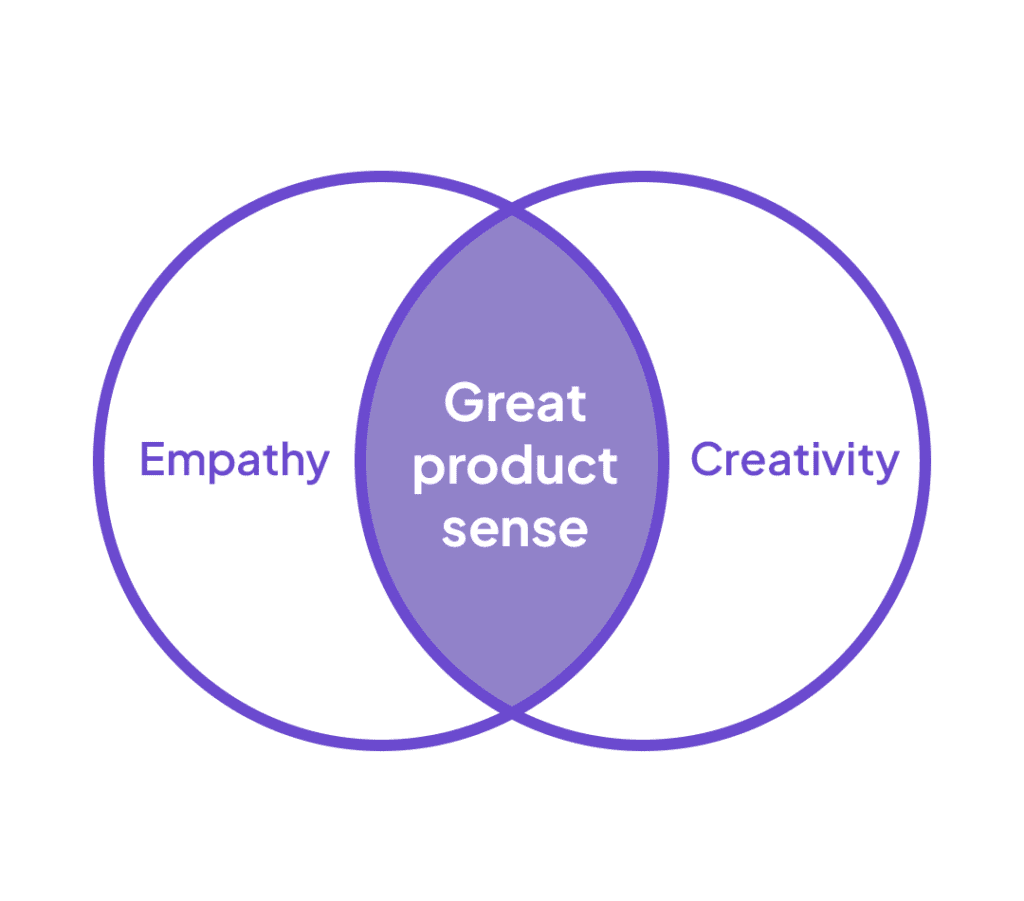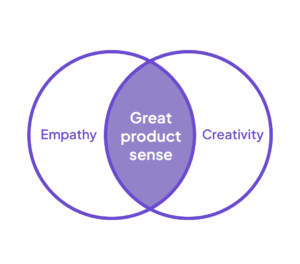How to Develop Product Sense as a B2B Product Manager
-
Bella Williams
- 10 min read


Product sense
Product sense is a crucial skill for anyone involved in B2B product development. It involves understanding the products you’re working on and having a deep insight into the needs of your target customers. It is the intertwine between customer empathy and product creativity. Developing this skill takes time and effort, but with dedication, you can become a valuable asset to your team and contribute significantly to your company’s success. In this blog post, we will explore how to develop product sense as a B2B PM, the challenges that come with it, and how to overcome them.
What is Product Sense?
Product sense, a.k.a. the PM’s sixth sense, is their intuitive understanding of what drives a product’s success from a user’s perspective. PMs with strong product sense can anticipate user needs, identify problems, and come up with innovative solutions to improve a product.
Product Sense needs development; it’s not a natural talent
PMs develop this intuition over time with practice and experience. You’re not born with it. You work on so many problems and get used to complex situations that you advance yourself to make better decisions out of thin air.
Difficulty in Developing Product Sense
Product Sense isn’t necessarily an innate talent – it’s a skill that can be shaped, built, and improved over time. It is one of the core hard skills that successful product managers should master. A good product manager with this skill set will understand what product features make sense to a user, and which don’t. They will understand the challenges faced by users and create effective solutions to address them. Possessing a keen product sense is a fundamental aspect of product development and plays a vital role in shaping any product roadmap. This skill is indispensable for crafting impactful products that prioritize the needs of users.
However, developing product sense can be challenging. The difficulty of the various aspects of developing product sense can vary depending on an individual’s background, experience, and natural inclinations. What one person finds challenging, another might excel at. However, some aspects are generally considered more challenging due to their complexity or the skills and mindset they require.
Let’s break down these aspects:
- Solution Discovery: This phase can often be the most challenging. It involves not only identifying problems but also devising innovative and effective solutions. Creativity, critical thinking, and the ability to balance user needs with technical feasibility and business goals are crucial here. Generating truly valuable and feasible solutions can be a complex task.
- User Discovery: While understanding user needs is fundamental, it can be challenging because it requires empathy and the ability to put yourself in the user’s shoes. It also involves interpreting user feedback and behavior, which can be nuanced and multifaceted.
- Problem Discovery: Identifying the right problems to solve can also be difficult. Sometimes, what seems like a problem on the surface may not be the root issue. It requires digging deep, asking the right questions, and being able to differentiate between symptoms and causes.
As mentioned earlier in this article, it is important to note that the level of difficulty can vary from person to person. Some individuals naturally excel at one aspect while finding another more challenging. However, developing a well-rounded product sense typically involves continuous learning and improvement in all three areas.
Collaboration and a diverse team can also help mitigate individual challenges by bringing together complementary skills and perspectives.
Practical tips for developing Product Sense
1. Practice product teardown
Product teardown does not imply selecting and criticizing a product. Rather, reverse engineering a product to gain a better understanding of it. Asking questions like, what works for this product? Is it achieving the business goals? and so on. And then taking inspiration from that product. The inspiration can come from anything – from interactive UI to broader concepts like user onboarding and re-engagement. You can begin practicing product teardown by selecting a variety of products and focusing on what makes them unique. These products can be new or old, and they can solve specific to broader problems.
If you’ve chosen several apps, the best way to proceed is to install them, sign in, and use the app. You can begin by evaluating user onboarding – how the app’s UI makes the process simple. Then you can begin experimenting with the app’s functionality and UX. When you’ve thoroughly examined the app, you should be able to answer the following key questions: -What did I love the most about the app? -What didn’t I understand about it? -What other broader observation did I make? -What goals did the creators target? -What goals does the app actually fulfill? -What inspiration can I take from this product?
2. Define your goals
Establishing clear product goals is essential for developing a strong product sense. By defining SMART goals that are Specific, Measurable, Achievable, Relevant, and Time-bound, you can ensure your product remains focused on user needs. For instance, consider a software company developing a project management tool. By setting SMART goals such as improving collaboration features to increase user engagement among project teams by 20% within three months, they not only maintain alignment with their business clients’ needs but also enhance their product development skills. Continuously gathering user feedback and adapting goals as needed, such as improving the feature’s user-friendliness based on feedback, not only keeps your product in alignment with users but also enhances your product development skills as you work toward meaningful objectives.
3. Identify all available possibilities
Pproduct sense shouldn’t hinge on a PM’s ability to pinpoint a mythical “correct answer” (since it doesn’t exist). Instead, it should be gauged by their capacity to perform the following tasks when confronted with limited information:
- Identifying key issues with logical hypotheses.
- Crafting high-level solutions supported by solid justifications.
- Grasping the potential advantages and disadvantages of each solution.
- Knowing which questions to pose next.
The capability to chart all potential paths and obstacles propels a product closer to its objectives, even in situations of extreme uncertainty.
4. Leverage empathy
Understanding and empathizing with the needs, challenges, and perspectives of your target users is a cornerstone of developing a strong product sense. By putting yourself in the shoes of your users, you can better anticipate their preferences, identify pain points, and create solutions that genuinely resonate with them. This empathetic connection not only fosters user trust and loyalty but also guides your decision-making process, ensuring that your product truly addresses user needs and provides a superior experience.
5. Practice! Practice! Practice!
Finally, similar to mastering any skill, practice is the key to excellence. Developing and refining this skill will enable you to cultivate an intuitive understanding of what constitutes exceptional products, allowing you to craft the most effective features for users.







